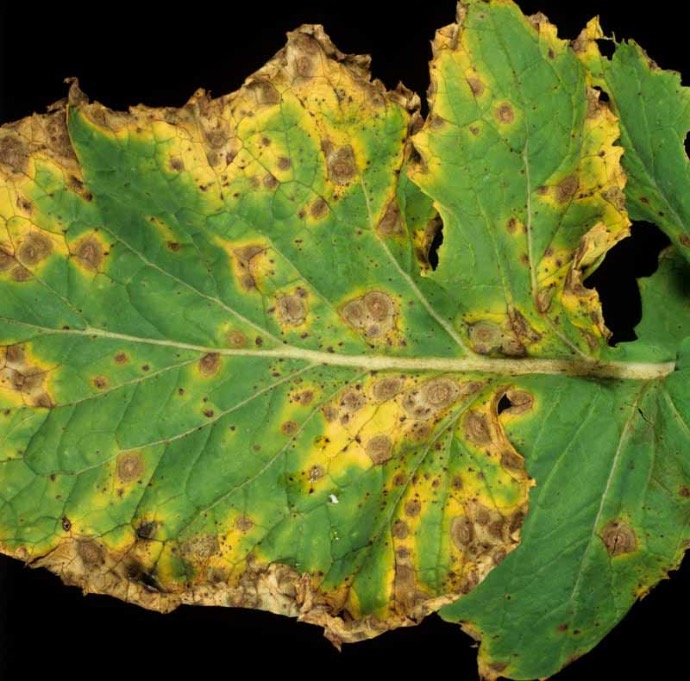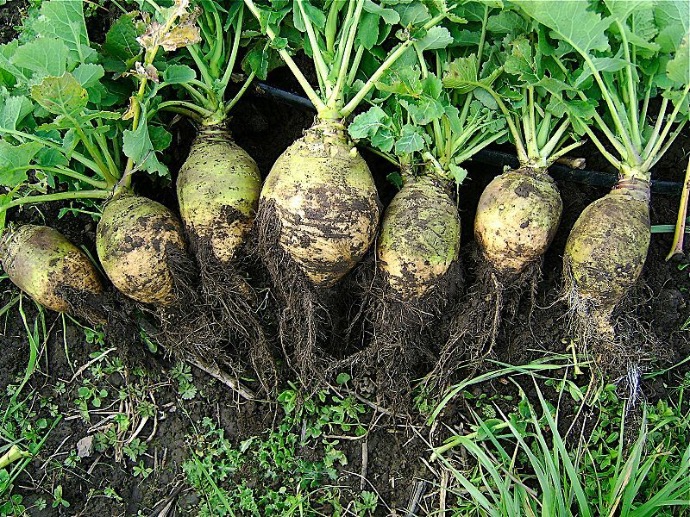Rutabaga
Rutabagas are biennials, 12-24 inches tall, and frost-tolerant. They prefer well-drained, fertile soil in full sun to partial shade. Keep the soil moist. Rutabagas are edible but not medicinal.
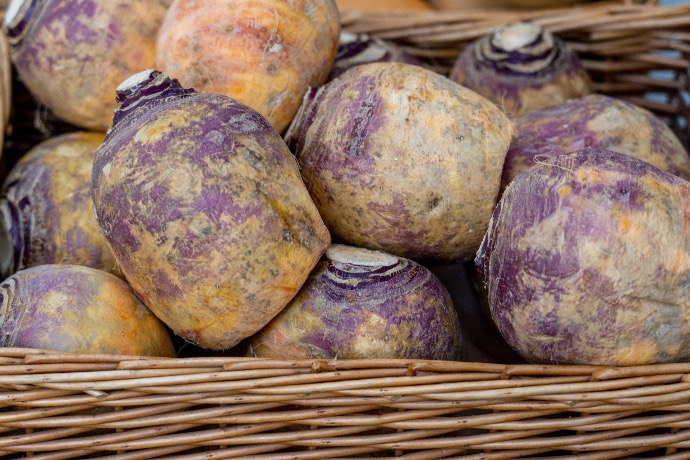
Habit
Tree
Height
30-60 cm
Growth
moderate
Soil
Well-drained loamy
Shade
Full sun to partial shade
Moisture
Moist
Edible
Yes
Medicinal
No
Origin
Europe
Climatic Condition
Temperate, Cool Climate
Temperature (°)
10-22°C
Humidity (%)
50-80%
Potting media
Field soil
Fertilizers
Nitrogen-rich fertilizers
Watering
Regular
Plant Weight
500 g - 2 kg
Flowering Time
Fall to Winter
Soil Ph level
6.0 - 7.5
Water Ph level
6.0 - 7.5
Soil EC
1-2 dS/m
Yield Per Plant
3-5 kg per plant
NPK ratio
10:10:10
life Span
Biennial
Health Benefits
High in Vitamin C, fiber
Suggested Grow Media or Potting Mix ?
50% loam, 25% compost, 25% sand
Suggested Fertigation/Fertilizers
Fertilize every 4 weeks with a balanced fertilizer.
Common Diseases and Remedies
Root Rot, Leaf Spot, Nematodes
stunted, wilt easily and may have yellowing leaves, irregular club shaped roots
Crop rotation, neem cake as soil amendment
HEALTH BENEFITS
· High in fiber, vitamins C and K, supports digestion and bone health.
· Contains glucosinolates, which may help prevent cancer.
What is a rutabaga plant?
Rutabaga or swede is a root vegetable from the genus Brassica napus. Other names include Swedish turnip, neep, and rutabaga. But elsewhere the name "radish" usually means white radish. Brassica napus is obtained from a hybrid of cabbage and radish.
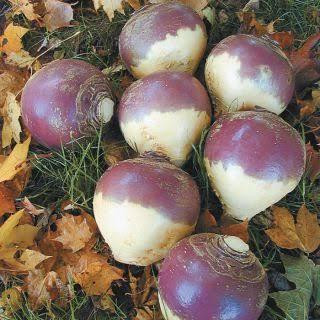
What Are The Different Types Of Rutabaga Plants?
1. Gilfeather
The upper parts of this variety are green and the flesh is white. It was built in the 1800s by John Gilfeather of Wardsboro, Vermont.
2. York
This variety has bloody upper parts and is resistant to tuber. It was built in the Maritimes State.
3. Helenor
This variety has tension and grows slower than other varieties.
4. Nadmorska
This variety has green upper parts and golden flesh. Brought to North America by Adaptive Seeds in Oregon.
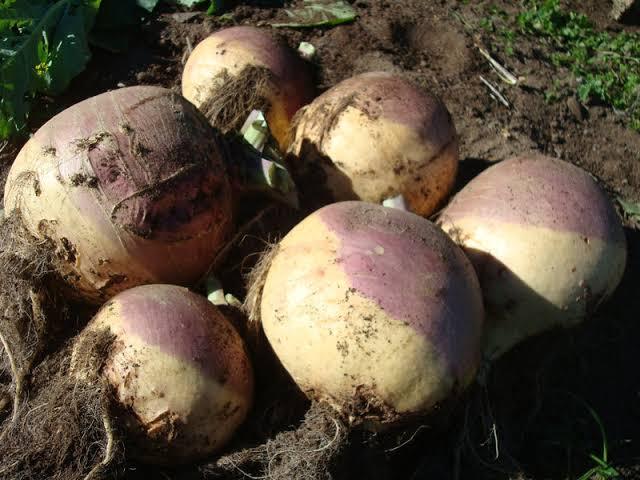
1. Location
Rutabaga likes full sun (or light shade). Plant them in the ground or in a raised bed in deep, loose soil without stones or clods. While rutabagas can tolerate neutral soil, the roots will grow in rich soil rich in compost or organic matter.
2. Sun light
The flesh of rutabagas is yellow, larger than radishes, and sweet. They take longer to mature: usually three to four months. Both crops need full sun (at least 6 hours per day) and fertile soil with a pH close to (6.8 to 7.5).
3. Soil
Rutabagas will grow best in slightly acidic to neutral soil with pH levels 6 to 7. Apply phosphorus (P) and potassium (K) according to soil test recommendations. Many Minnesota soils have enough phosphorus.
4. Hydration
Rutabaga must have sufficient moisture to be of good quality. Most soils need 1 1/2 inches of water every seven to ten days. When it comes to root growth, moisture is most important.
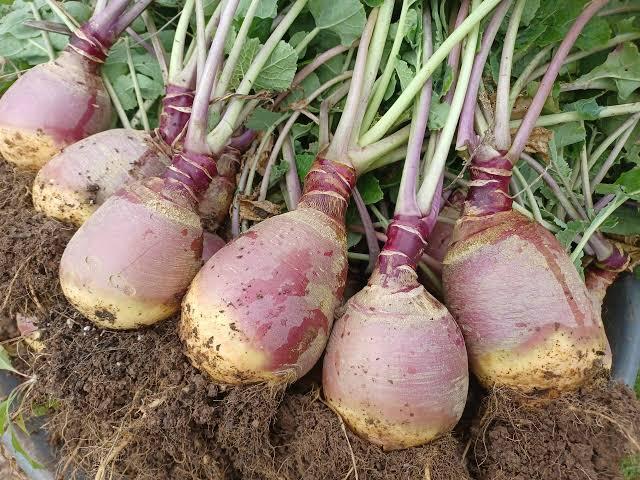
5. Nourishment
Rutabaga plants (Brassica napus var. napobrassica) are root vegetables that require certain nutrients to thrive and produce healthy roots. Here are some key nutrients you need to grow rutabagas:
1. *Nitrogen (N):* Nitrogen is essential for leaf growth and all important plant growth. Incorporating nitrogen-rich fertilizers or organic amendments such as compost, old manure, or rice blood into the soil before planting can help provide needed nitrogen to rutabaga plants.
2. * Phosphorus (P):* Phosphorus supports root development and helps plants develop a strong root system. Adding phosphorus-rich fertilizer or bone meal to the soil before planting can help promote healthy root development of the rutabaga plant.
3. *Potassium (K):* Potassium contributes to overall plant health and helps regulate water uptake and nutrient transport. Applying a potassium-rich fertilizer or adding potassium sulfate to the soil can help increase the growth and disease resistance of your rutabaga plants.
4. *Calcium (Ca):* Calcium is important in preventing diseases such as tuber in rutabaga plants. Adding a calcium-rich amendment, such as gypsum or lime, to the soil can help maintain calcium levels and prevent nutrient deficiencies.
5. *Micronutrients:* Rutabaga plants also need various micronutrients such as iron, manganese, zinc and boron for health and growth. Soil testing can help identify micronutrient deficiencies, and foliar sprays or soil amendments can be used to correct deficiencies.
Issues
Nitrogen - Excess can affect crops, inhibiting growth and shortening the life of the crop. Excessive nitrogen and plant pressure can cause rutabaga roots to grow too long. Usually nitrogen is spread and incorporated into the soil before planting.
What are the benefits of the rutabaga tree?
Rutabaga has many health benefits:
fibers. They are the best source of roughage in the diet. ...
calories less. Adding turnips to your diet may aid weight loss, which may help prevent long-term (chronic) diseases such as diabetes and heart disease.
High potassium.
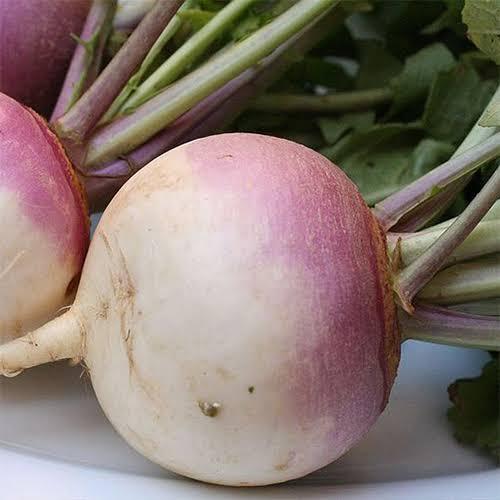
FAQs About Growing Rutabaga
1. How long does it take for rutabaga to grow?
Since rutabaga roots ripen best in cold weather, they must be planted in time to ripen in cold weather. Rutabagas are ideal as fall crops in cooler climates or winter crops in warmer climates. It takes approximately 80 to 100 days from planting to harvest.
2. Where do rutabagas grow best?
Rutabagas grow best in slightly acidic to neutral soil with a pH of 6 to 7. Use phosphorus (P) and potassium (K) according to soil test recommendations. Most Minnesota soils are rich in phosphorus
3. How much space do rutabagas need?
Planting and spacing : Rutabagas can be planted in rows 14 to 18 inches apart. Till the soil to create a good seed bed and fertilize well. Sow the seeds 1/2 inch deep, with plants about 4 inches apart. Seeds can be better sown initially and then thinned to 4 inches apart.
4. How long can rutabagas be stored?
As a rule, they can last up to 6 months; in a dark, cool place, such as a cellar or unheated garage. They can be stored frozen for 6 months to 1 year. If you want to freeze rutabagas, first wash them with water and scrub the vegetables.
5. What can rutabaga be planted with?
Cabbage, cauliflower, broccoli, Brussels sprouts, turnips, and turnips have similar likes and dislikes, insects, and diseases. Aromatic herbs or plants with large flowers such as dill, sage, onions, potatoes will be helpful. They do not like strawberries, tomatoes and lentils.
